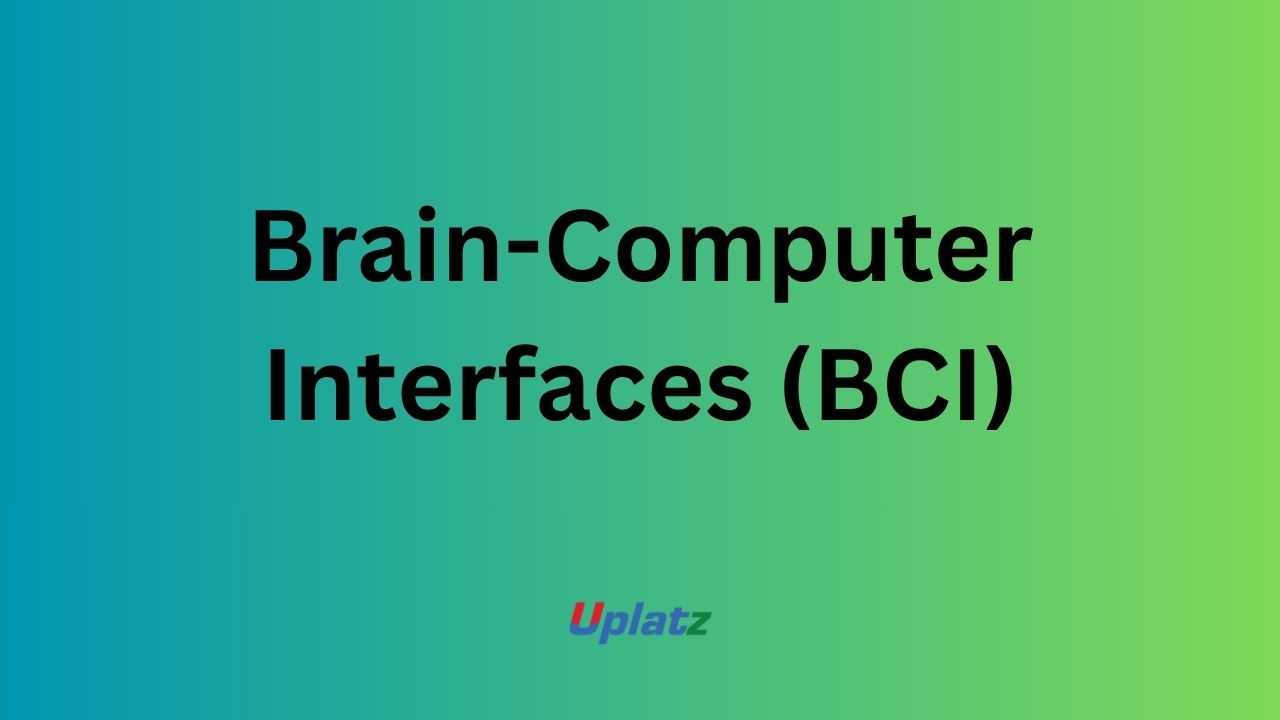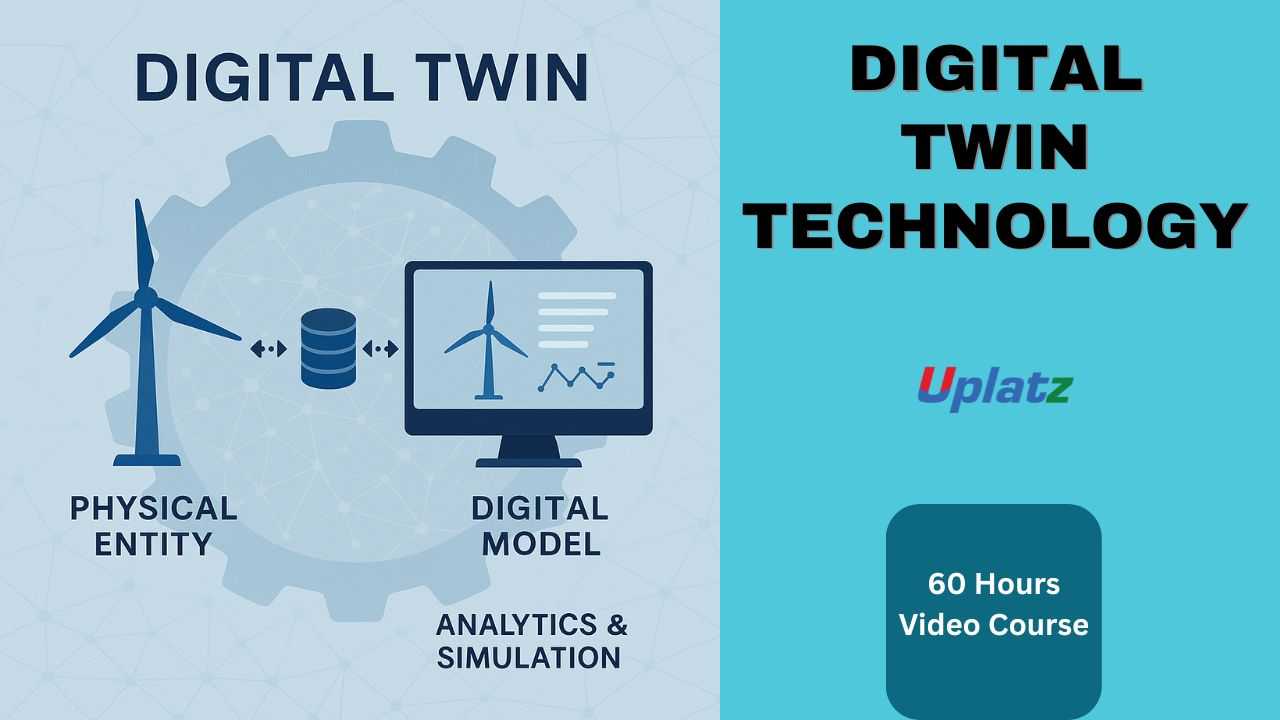Brain-Computer Interfaces (BCI)
Connect the Human Brain with Machines Through Neural Signal Processing and AI Price Match Guarantee
Full Lifetime Access
Access on any Device
Technical Support
Secure Checkout
Course Completion Certificate
Price Match Guarantee
Full Lifetime Access
Access on any Device
Technical Support
Secure Checkout
Course Completion Certificate
 97% Started a new career
BUY THIS COURSE (
97% Started a new career
BUY THIS COURSE (GBP 12 GBP 29 )-
 86% Got a pay increase and promotion
86% Got a pay increase and promotion
Students also bought -
-

- Digital Twin Technology
- 60 Hours
- GBP 12
- 669 Learners
-

- Federated Learning
- 10 Hours
- GBP 12
- 10 Learners
-

- Green AI: Sustainable & Efficient AI Development
- 10 Hours
- GBP 12
- 10 Learners

Brain–Computer Interfaces (BCIs) represent one of the most revolutionary developments at the intersection of neuroscience, biomedical engineering, artificial intelligence, and human–machine interaction. BCIs enable direct communication between the human brain and external devices — allowing thoughts, neural patterns, or cognitive states to control software applications, machines, prosthetics, or immersive environments.
This Uplatz self-paced course offers a complete roadmap to understanding, designing, and implementing modern BCI systems. You will learn how to record brain activity, process neural signals, extract meaningful features, and build AI-driven models that interpret cognitive states or motor intentions. From foundational neuroscience to hands-on implementations with OpenBCI, BrainFlow, MNE-Python, and deep learning frameworks, this course bridges theory with real-world application.
🔍 What is a Brain–Computer Interface (BCI)?
A Brain–Computer Interface is a system that captures brain signals, interprets them using computational models, and translates them into commands for external devices. Instead of relying on muscles or physical movement, BCIs read the brain’s electrical or metabolic activity — such as EEG (electroencephalography), fNIRS (functional near-infrared spectroscopy), or ECoG (electrocorticography) — to allow direct control of computers, assistive technologies, robotic systems, and digital environments.
BCIs are used for:
-
Restoring movement for individuals with paralysis
-
Controlling robotic arms or prosthetics
-
Monitoring cognitive workload or stress
-
Enabling communication for patients with ALS or locked-in syndrome
-
Creating immersive gaming and VR experiences
-
Enhancing neurofeedback therapies and rehabilitation
The field is rapidly evolving as AI and deep learning improve the accuracy and robustness of neural decoding, making BCIs increasingly practical and widely applicable.
⚙️ How Do BCIs Work?
BCIs operate through a pipeline of neuroscience, signal processing, and machine learning:
1. Signal Acquisition
Record brain activity using tools such as:
-
EEG: non-invasive, widely used for real-time BCIs
-
fNIRS: tracks blood-oxygen changes linked to brain activity
-
ECoG: invasive but highly accurate for clinical applications
-
Wearable EEG devices: OpenBCI, Muse, NeuroSky
2. Preprocessing
Remove noise, artifacts, and interference from raw neural signals using filtering, ICA, channel selection, and normalization.
3. Feature Extraction
Identify meaningful patterns using methods such as:
-
Time–frequency analysis
-
CSP (Common Spatial Patterns)
-
Wavelets
-
Power spectral density (PSD)
4. Classification / Neural Decoding
Apply AI models to interpret cognitive states or intentions:
-
SVM, Random Forests, LDA
-
CNNs and RNNs for deep learning
-
Transformer-based neural decoders
5. Real-Time Feedback
Translate decoded signals into control actions — moving a cursor, selecting an option, operating a robot, or triggering a virtual environment.
This course walks you through the complete workflow step-by-step, enabling you to build functional BCI applications by the end.
🏭 How BCIs Are Used in Industry
Brain–Computer Interfaces are reshaping industries including:
1. Healthcare and Neurorehabilitation
Used for motor recovery, stroke rehabilitation, prosthetic control, and neurofeedback therapy.
2. Assistive Technologies
Enable communication for individuals with paralysis, ALS, or speech impairments through thought-based interfaces.
3. Robotics and Automation
BCIs allow hands-free robotic control, drone navigation, and neural-driven exoskeletons.
4. Gaming and VR/AR
Used in immersive experiences where players interact through mental commands or emotional states.
5. Human–Machine Interaction
Integration of BCIs into smart environments, IoT systems, and adaptive interfaces for real-time cognitive feedback.
6. Research and Cognitive Science
Used to study attention, memory, emotion detection, and cognitive workload.
As tech giants like Meta, Neuralink, Blackrock Neurotech, Emotiv, and OpenBCI invest heavily in BCI innovation, skills in BCI development and neural decoding are becoming extremely valuable.
🌟 Benefits of Learning BCIs
By mastering BCIs, you gain:
-
Deep interdisciplinary knowledge across AI, neuroscience, and biomedical systems.
-
Hands-on experience with EEG and neural decoding frameworks, an in-demand skillset for research and industry.
-
Ability to design assistive and neurotech applications that have real societal impact.
-
Competitive advantage in emerging fields like neuroengineering, cognitive AI, and human–computer interaction.
-
Practical expertise in signal processing and machine learning, applied to real-world biological data.
-
Career pathways in healthcare tech, robotics, brain analytics, neurofeedback, gaming, and research labs.
BCI development is a fast-growing technology domain with high demand for engineers, data scientists, and neurotech innovators.
📘 What You’ll Learn in This Course
Although the detailed syllabus is available separately, your learning path includes:
-
Fundamentals of brain structure and electrophysiology
-
EEG, fNIRS, and ECoG signal characteristics
-
Noise removal, filtering, and preprocessing techniques
-
Feature extraction using frequency, spatial, and temporal methods
-
Machine learning for neural classification and pattern recognition
-
Deep learning for motor imagery, emotion detection, and cognitive state decoding
-
Hands-on BCI development with OpenBCI, BrainFlow, and MNE-Python
-
Real-time feedback and system control mechanisms
-
Mini-projects: attention tracking, emotion classification, robotic control
-
Capstone project: build and demonstrate a fully functioning BCI prototype
🧠 How to Use This Course Effectively
To maximise your progress:
-
Begin with neuroscience basics — neurons, brain waves, and cortical regions.
-
Understand signal types: EEG, fNIRS, and invasive vs. non-invasive recordings.
-
Follow hands-on labs with OpenBCI or Muse to acquire real EEG data.
-
Implement preprocessing pipelines using Python and MNE.
-
Build classifiers for motor imagery, workload detection, or emotion decoding.
-
Experiment with deep-learning-based neural decoders.
-
Work through mini-projects to reinforce each stage of the pipeline.
-
Complete your capstone: design a working BCI system that translates thoughts into actions.
-
Review challenging modules and refine your neural models for better accuracy.
👩💻 Who Should Take This Course
This course is ideal for:
-
Machine Learning Engineers & AI Researchers
-
Neuroscientists and Cognitive Science Students
-
Biomedical Engineers
-
Robotics Developers
-
Data Scientists working on biological or temporal signals
-
Developers exploring neurotech, BCI gaming, or human–machine interaction
-
Innovators building assistive or healthcare technologies
No prior BCI experience is needed — only basic Python and machine learning knowledge.
🚀 Final Takeaway
Brain–Computer Interfaces are redefining how humans interact with technology. This Uplatz self-paced BCI course gives you the theoretical understanding, analytical skills, and hands-on experience to build real neural-driven applications.
By the end of the course, you will be able to design, train, evaluate, and deploy complete BCI systems — combining neuroscience and AI to create the next generation of brain-controlled interfaces.
-
Understand the fundamentals of brain–machine communication.
-
Learn the different BCI signal acquisition methods (EEG, ECoG, fNIRS).
-
Master EEG data collection and preprocessing techniques.
-
Apply AI algorithms to decode neural signals.
-
Explore motor-imagery-based and cognitive BCIs.
-
Build adaptive interfaces using machine learning and deep learning.
-
Integrate hardware platforms like OpenBCI and Muse.
-
Study real-world applications in medicine, neuroprosthetics, and gaming.
-
Address ethical and privacy considerations in neural data use.
-
Prepare for research and development roles in neuro-AI innovation.
Course Syllabus
Module 1: Introduction to Neuroscience and Brain Signal Basics
Module 2: Overview of Brain-Computer Interfaces – History and Evolution
Module 3: EEG, ECoG, and fNIRS Signal Acquisition
Module 4: Signal Preprocessing and Noise Reduction Techniques
Module 5: Feature Extraction – Frequency, Time, and Spatial Domains
Module 6: AI and Machine Learning for Neural Decoding
Module 7: Real-Time BCI Systems and Feedback Loops
Module 8: BCI Hardware and Open-Source Tools (OpenBCI, BrainFlow, MNE-Python)
Module 9: Ethical, Legal, and Privacy Aspects of Neural Interfaces
Module 10: Capstone Project – Build and Test a Working BCI Prototype
Upon successful completion, learners receive a Certificate of Completion from Uplatz, validating their knowledge of Brain-Computer Interfaces (BCI) and applied neurotechnology.
This Uplatz certification demonstrates your ability to design, train, and deploy AI-powered BCI systems that interpret neural signals and enable seamless human–machine interaction.
The certification aligns with fast-growing industries such as neuroengineering, assistive technologies, AR/VR interfaces, and cognitive computing, making it a valuable credential for researchers and developers entering this emerging field.
Earning this certification showcases your capability to work at the intersection of AI, neuroscience, and biomedical engineering, designing technologies that expand the boundaries of human–computer communication.
Brain–Computer Interface specialists are pioneering a new wave of neurotechnology careers. Completing this course from Uplatz prepares you for high-demand roles such as:
-
Neurotechnology Engineer
-
BCI Research Scientist
-
Biomedical Data Scientist
-
Cognitive Systems Developer
-
Neural Signal Processing Engineer
Professionals in this domain typically earn between $110,000 and $200,000 per year, depending on industry and expertise.
Career opportunities are expanding across medical device companies, AI research labs, rehabilitation tech startups, and gaming industries, where BCIs enhance accessibility, control, and immersive experience. This course provides the scientific and technical foundation to build intelligent neural interfaces that redefine the limits of human–machine collaboration.
-
What is a Brain-Computer Interface (BCI)?
A system that translates brain activity into digital commands, allowing control of external devices. -
What are the main types of BCIs?
Invasive (implanted), semi-invasive, and non-invasive (EEG, fNIRS). -
How does EEG capture brain activity?
By measuring electrical signals produced by neurons using scalp electrodes. -
What role does AI play in BCIs?
It decodes complex brain signals into actionable commands using ML algorithms. -
What are common preprocessing steps for EEG data?
Filtering, artefact removal (e.g., eye blinks, muscle noise), and normalization. -
What is motor imagery in BCI systems?
The mental simulation of movement used to generate distinguishable neural patterns for control. -
What is neurofeedback?
Real-time feedback that allows users to train their brain activity for performance improvement. -
Which frameworks are commonly used in BCI development?
OpenBCI, BrainFlow, MNE-Python, and BCI2000. -
What are key challenges in BCI research?
Signal noise, inter-subject variability, and ethical concerns about neural data. -
What are real-world applications of BCIs?
Prosthetic control, rehabilitation, gaming, attention tracking, and emotion monitoring.









